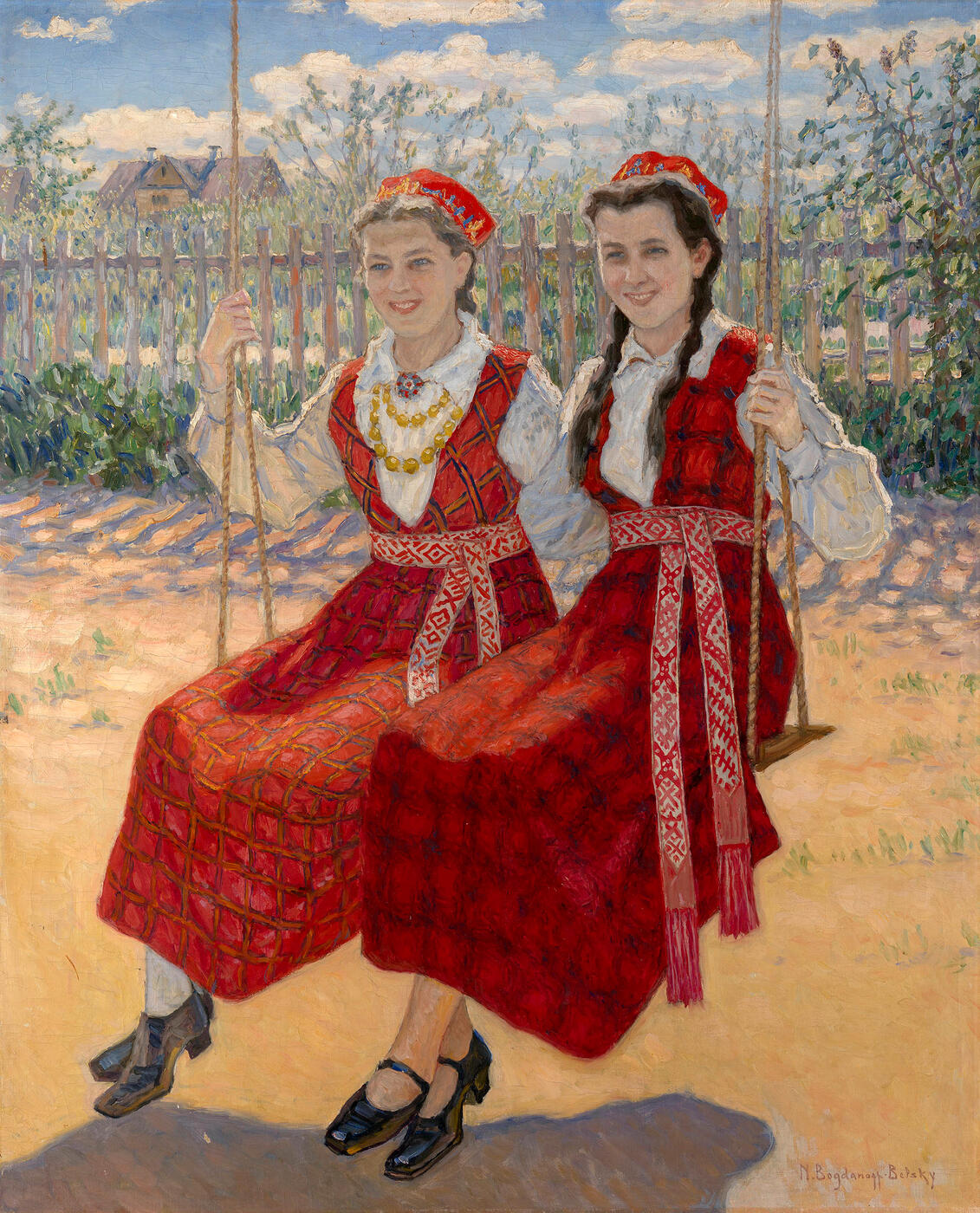MacDougall's Russian Art Auctions 8-9 June 2011
8 June 2011

* 75. BOGDANOV-BELSKY, NIKOLAI (1868-1945)
Two Girls on a Swing, signed.
Oil on canvas, laid on board, 85.5 by 70 cm.
120,000-180,000 GBP
Provenance: Acquired directly from the artist by the present owner's family in 1940.
Private collection, Latvia.
Thence by descent.
Private collection, Canada.
This work will be included in the book on N. Bogdanov-Belsky being prepared by A. Kouznetsoff.
Nikolai Bogdanov-Belsky painted Two Girls on a Swing in Latvia, where the famous artist had moved to in the autumn of 1921. He had been celebrated in Russia for his portraits of peasant children and, after emigrating, he continued to work on his favourite subject. For many years he would set out every summer on journeys around Latvia, searching for the images of peasant children that were so dear to him. The countryside of the area, with the River Daugava, fields, forests, small woods and many picturesque lakes conquered Bogdanov-Belsky's heart and he decided to paint a series of Children of Latgalia. An array of different children began to fill his canvasses, often dressed in traditional national costume. They are depicted fishing or bathing in the lake, light-ing fires in a field beyond the confines of their farmstead, collecting brush-wood in the forest, sitting on a fence, playing, swinging on swings…
Friends, acquaintances and their families often commissioned portraits from the artist. Two Girls on a Swing is one such work. It was painted in the summer of 1940 on the Gulbene estate, commissioned by a local resident, Alexander Cauka. Bogdanov-Belsky first visited this area in 1937 and immediately fell in love with the picturesque environment of the estate. It was here that he painted his outstanding landscapes A Corner of the Park, Gulbene Park, Holy Lake, The Park in Autumn and others. The artist was so captivated with plein-air work that he admitted in letters to his wife that "I'm working hard… I get up every day at seven, work until lunch, have lunch at one, work again from two till five, have tea at five and from six I work again, till eight. Supper at half past eight, after which I go to bed at half past nine… The surroundings here are extremely beautiful, whichever way you turn - you can paint everything. There's a mass of material for a landscape artist."
But alongside the Gulbene countryside, the artist was undoubtedly also charmed by the local children. It was with good reason that Cauka, on one of Bogdanov-Belsky's later visits to the estate, asked him to paint a double portrait of his daughter Erita and her friend. The family of the girl portrayed in the picture still has a photo showing the artist with his fidgety young models, in the process of painting the picture. Both girls are wearing Latvian national dress - bright red, checked tunics with white blouses, with ornate embroidered belts. Traditionally, such costumes varied slightly from region to region, while retaining the same fundamental components. Among these was the national headdress for girls, a kind of chaplet made from stiff card covered with beautiful fabric and embroidered with beads and spangles. Also clearly seen in the portrait is traditional Latvian jewellery: amber beads and a brooch, with red stones and tiny silver leaves, used to fasten a blouse or villaine shawl.
Nevertheless, despite the close attention paid to costume details, the artist's characteristically Impressionistic painting style is visible everywhere: in the reflections of the bright summer sun on the girls' hair and faces, in the vivid, vibrant green of the background, in the clouds scudding across the sky and the shadow of the fence and swing on the sand. Bogdanov-Belsky, a master of the plein-air technique, skilfully demonstrates in this portrait his talent for capturing the fleeting light conditions, conveying an atmosphere of the happy, sunny, youthfulness and beauty of his models. All this makes Two Girls on a Swing an outstanding example from the artist's cycle of works - now dispersed all over the
world - of the Children of Latgalia.
Notes on symbols:
* Indicates 5% Import Duty Charge applies.
Ω Indicates 20% Import Duty Charge applies.
§ Indicates Artist's Resale Right applies.
† Indicates Standard VAT scheme applies, and the rate of 20% VAT will be charged on both hammer price and premium.